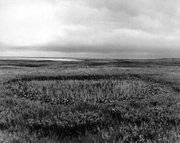Arctic Tundra Province
Contents
Arctic Tundra Province (Bailey)
Northern arctic coastal plain, 19,100 mi2 (49,500 km2)
Land-surface form
The north coast of Alaska is a broad, level plain that is generally less than 1,000 ft (300 m) in elevation. Rolling foothills rise near the Colville River and gain altitude southward into the Brooks Range. In summer, thousands of lakes and marshes dot the plain.
Climate
The severe arctic climate reaches temperatures of -60F (-51C) in winter. Average annual temperature is only 10 to 20F (-12C to -6C). Due to its location in the extreme north, this province gets very different amounts of sunlight (Solar radiation) at different times of year. In summer, the sun remains above the horizon 24 hours a day for from 2 to 85 consecutive days, depending on the latitude; in winter, it can remain below the horizon 24 hours a day for as long as 67 consecutive days. All sunlight is received at oblique angles that average 41 degrees. The growing season averages only 2 weeks per year. Precipitation is very low throughout the year; average annual precipitation is only 7 in (180 mm).
Vegetation
Permafrost limits the rooting depth of plants and forces surface water to drain by preventing it from seeping into the soil. Extensive marshes and lakes result. Cottongrass-tussock, the most widespread vegetation system in the Arctic, is associated with sedges, dwarf shrubs, lichens, mosses, dwarf birch, Labrador-tea, and cinquefoil. These highly productive systems produce 500-1,000 lb (227-454 kg) of vegetation per acre, an important source of food for caribou and waterfowl. Several forbs flower brightly in the short summer.
Soils
The soils are wet, cold Inceptisols with weakly differentiated horizons. Soils on south slopes and low moraines are well drained and loamy, with permafrost and ice features. They are underlain by coarse outwash and till. The uplands have localized areas of poorly drained clayey soils; lowland soils are deep, wet, and silty. There is no surface water in winter and only moderate flows in summer. Supplies of ground water are very limited. The entire province is under continuous permafrost to depths of 2,000 ft (600 m) in some areas.
Fauna
Mammals of the Arctic include brown bear, wolf, wolverine, caribou, arctic hare, mink, weasel, and lemming. Polar bear, walrus, and arctic fox are common on the ice pack and coastal areas during winter.
Shore and lake areas provide rich habitat for millions of migrating waterfowl and shore birds during the summer months. Ptarmigans, ravens, hawks, and open country owls are common. Gyrfalcons have also been seen on sea ice.
Return to Ecoregions of the United States
| Disclaimer: This article is taken wholly from, or contains information that was originally published by, the United States Forest Service. Topic editors and authors for the Encyclopedia of Earth may have edited its content or added new information. The use of information from the United States Forest Service should not be construed as support for or endorsement by that organization for any new information added by EoE personnel, or for any editing of the original content. |
